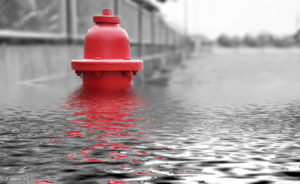
Predict, Monitor, and Mobilize: Deploying AI for Smart Disaster Response

(John Williams RUS/Shutterstock)
As climate change unfolds, natural disasters that strike with previously unthinkable force have become our new normal. Floodwaters rise higher, winds blow harder and lives and livelihoods are in greater danger than ever before.
Incorporating AI and machine learning into natural disaster response has become de rigeuer in the last few years. As this technology evolves and the need to confront climate change escalates, technologists are rapidly pushing AI’s ability to predict, monitor and mobilize disaster response further than ever before.
Looking at the latest examples of AI usage in disaster management — highly accurate forecasts, optimizing aid deployment and real-time monitoring, to name a few — we can take stock of how AI can help us adapt to climate change today, and prepare for a more resilient tomorrow.
Data-driven Disaster Response
From dispensing resources to vulnerable communities, to estimating how we should preventatively insure storm infrastructure, the applications of AI in disaster response are innumerable…and most rely on making decisions about data.
Sourcing and selecting the most comprehensive and valuable weather data possible for climate projects can prove a challenge.  Nationally and internationally, there are no historic or current standards for the collection or cleansing of disaster data. As more programmers apply AI to disaster response, the predictive capabilities of algorithms may end up varying widely depending on the sources, number of datasets and cleansing decisions made by individuals.
Nationally and internationally, there are no historic or current standards for the collection or cleansing of disaster data. As more programmers apply AI to disaster response, the predictive capabilities of algorithms may end up varying widely depending on the sources, number of datasets and cleansing decisions made by individuals.
No matter how cleverly calibrated, machine learning’s abilities are only as accurate as the datasets it learns from. In other words, disaster response is limited, to an extent, by reliance on historical weather data. It’s up to the discretion of programming teams how far back they should go for this data — one year, a decade or a century — and if that data is of high enough quality to incorporate.
Data sharing and greater transparency between regions and nations may become far more common practice as we respond to climate change on a global scale.
However, AI advances even within the last year have vastly improved predictive accuracy, and a bright future of precise forecasting and real-time monitoring lies ahead.
Forward-thinking Forecasting and Modern Monitoring
In a natural disaster, every moment matters. With the surveillance powers of sensors and satellites, AI is realizing a long-term ambition of real-time monitoring. Examples of cutting-edge applications to climate disasters can be found in Australia, Germany and Canada.
Bushfire Detection in Australia
Australian wildfires dominated headlines in 2019 and 2020. These bushfires killed 34, displaced 65,000 people, destroyed 3,100 homes and killed or displaced an estimated 3 billion animals, including endangered species. In response, Australian company Attentis mounted the world’s largest real-time environmental monitoring network. This integrated, high-speed web of sensors is powered by AI that collect and deliver vital data, moment to moment.
This data is fully accessible by emergency responders, as well as local and neighboring residences, to monitor rainfall, air quality, fire starts, weather and more. Local officials can make informed decisions faster, and issue early flood alerts, especially to people in areas at the highest risk of inundation.
Flood Protection in Germany
In the past 20 years, flooding has become the most common natural disaster, accounting for 43% of all recorded disaster events. Predicting floods is tricky, even for meteorologists; real-time rainfall and rate-of-change up hills and basin slopes must be considered. Plus, monitoring for infrastructure holding back water is still being implemented in many areas.
Germany’s Ahr Valley sustained 184 deaths in historic European flooding in July 2021. In the summer of 2022, a hackathon team from Heidelberg, Germany evaluated weather, runoff and sensor data and incorporated risk maps to simulate disasters. Now, officials can better predict and respond to heavy rainfall events and issue timely flood warnings to give residents their most valuable resource in a disaster: time.
Satellite imagery is another valuable source of disaster data AI can analyze to powerful effect. For the same hackathon, team LiveEO #2 applied open-source tools and visualization to a combination of near real-time satellite imagery and remote-sensing data. The goal? To improve flood risk modeling for insurance companies and mitigate the worst financial effects of disaster.
Disaster Relief in Canada
A team of Deloitte technologists have connected disaster prediction, monitoring and mobilization into a single analytics platform. It’s designed to optimize how the Canadian government and other relevant organizations responds to disasters, as well as bolster the country’s resilience in the face of climate change.
DRAi’s primary interface is an interactive map of Canada. Using a century’s worth of weather and demographic datasets, as well as real-time sensor data, government users can understand which regions of Canada are more vulnerable to disasters. This empowers the Canadian government to optimize funding distribution and foresee where to implement preventative measures before disaster strikes. With the ability to see the macro and the micro, drilling down into further charts and visualizations, this innovation is intended to reduce hazard exposure in vulnerable communities and increase the country’s overall resilience.
With cities like Seoul moving to integrate big data and disaster response platforms into smart city configurations, many more of these new-gen platforms to empower disaster response and relief could be the horizon.
AI Vs. Climate Change
With the limitations of climate data and, by nature of working with a tool that evolves as we use it, AI is not a cure-all for disaster response. It’s one of many forces we can rally to make necessary adaptations and shore up future resilience.
With that in mind, it’s our duty as technologists to dream big as we deploy AI in the fight against climate change. Artificial intelligence is the tool, but only human innovation can address climate change. By pooling our collective genius and sharing data and resources generously, AI can be a powerful part of mobilizing against natural disasters.
About the author: Marinela Profi is a data scientist and global product marketing manager for AI and analytics at SAS. She has applied her skills in deploying AI at scale, data mining and model development across a variety of sectors. Profi is a keynote speaker and global conference presenter on the data science industry. She is also a published author, contributor to several eBooks, and blog writer on major industry and data science blogs.
Related Items:
How Machine Learning Can Help Us Stop Climate Change
Esri Puts Federal Climate Change Action on the Map
AI Powers Sea Level Rise Visualizations
































